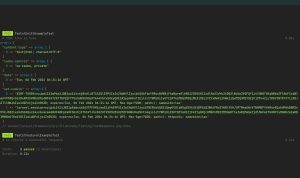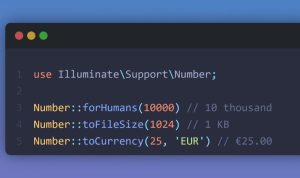Have you ever needed to assert part of an HTML response from within an HTTP test in Laravel? I recently needed to validate parts of a response to verify an important piece of content was rendered. For example, let’s say you have a critical JavaScript file that you want to ensure is contained within the DOM?
Here’s the testing API we are going to build:
$node = $response->get('/')
->crawl()
->filter('a')
->reduce(function (Crawler $node): bool {
return $node->attr('href') === 'https://rengga.dev/blog/';
});
$this->assertCount(1, $node);
There are a few options for parsing and traversing the DOM within PHP, such as PHP’s DOMDocument, PHPUnit’s DOM assertions (which are deprecated), Symfony’s DOMCrawler component, and various others. I happen to prefer Symfony’s DOMCrawler component, which has really powerful filtering, traversal and more.
Let’s see how we can quickly incorporate the DOMCrawler component in our Laravel HTTP tests!
Example
The gist of using the DOMCrawler is creating a new Crawler instance with the HTML content passed to the constructor:
use Symfony\Component\DomCrawler\Crawler;
$crawler = new Crawler($response->getContent());
foreach ($crawler as $domElement) {
var_dump($domElement->nodeName);
}
Using the Crawler instance directly works but is repetitive. Given Laravel’s powerful macro feature, we can quickly define a macro to crawl a TestResponse.
Here’s what the usage of my macro looks like:
$response = $this->get('/');
$crawler = $response->crawl();
// DOM traversal
// Assertions
If you want to try it out, define the following macro in a service provider’s boot() method:
use Illuminate\Support\ServiceProvider;
use Illuminate\Testing\TestResponse;
use Symfony\Component\DomCrawler\Crawler;
use PHPUnit\Framework\Assert as PHPUnit;
// ...
public function boot(): void
{
TestResponse::macro('crawl', function(?callable $callback = null): Crawler {
if (empty($content = $this->getContent())) {
PHPUnit::fail('The HTTP response is empty.');
}
$callback ??= fn ($c): Crawler => $c;
return call_user_func($callback, new Crawler($content));
});
}
Our macro does the following:
- Get the response content and fail the test immediately if it’s empty
- Create a pass-through callback if the user didn’t provide one using the null coalescing assignment operator
- Pass a new
Crawlerinstance through the callback, which should return aCrawlerinstance in the end
Using the null coalescing assignment operator, we avoid any if checks by providing a default pass-through callback if the user doesn’t pass one.
The idea of the callable is that the user could traverse the DOM, do some assertions, and ultimately return a subset of the DOM via crawl() if only a part of the DOM is needed:
// Return the full content
$crawler = $response->crawl();
// Filter and return the filtered crawler instance
$card = $response->crawl(function (Crawler $c) {
return $c->filter('a')
->reduce(function (Crawler $node) {
return $node->attr('href') === 'https://rengga.dev/blog/';
});
});
Maybe this example is a bit overkill, but let’s validate the Laravel News HTML included in the welcome.blade.php within a default Laravel installation:
use Symfony\Component\DomCrawler\Crawler;
// ...
/**
* A basic test example.
*/
public function test_the_application_returns_a_successful_response(): void
{
$response = $this->get('/');
$response->assertStatus(200);
// Find the Laravel News node
$card = $response->crawl()
->filter('a')
->reduce(function (Crawler $node) {
return $node->attr('href') === 'https://rengga.dev/blog/';
});
$this->assertNotEmpty($card, 'The Laravel News homepage card was not found!');
// Validate that the $card node has an H2 with `Laravel News`
$this->assertEquals(
'Laravel News',
$card->filter('h2')->first()->text()
);
// Validate that the page shows the blurb
$blurb = $card
->filter('p')
->reduce(function (Crawler $n) {
return str($n->text())->startsWith('Laravel News is a community driven portal');
});
$this->assertCount(1, $blurb);
}
Bonus
You may want to write more convenience helpers to validate DOM elements in your tests. For example, here’s a simple assertion that validates a node exists:
$response
->assertStatus(200)
->assertNodeExists('a[href="https://rengga.dev/blog/"]');
And here’s the macro I’ve defined, which also allows chaining with the TestResponse instance:
TestResponse::macro('assertNodeExists', function(string $selector): static {
$node = $this->crawl()->filter($selector);
$message = "Failed asserting the node exists with selector \"{$selector}\".";
PHPUnit::assertGreaterThan(0, $node->count(), $message);
return $this;
});
If the node doesn’t exist, here’s an example of what our macro will look like in our test output:
1) Tests\Feature\ExampleTest::test_the_application_returns_a_successful_response Failed asserting the node exists with selector "a[href="https://rengga.dev/blog/"]". Failed asserting that 0 is greater than 0.
I’d recommend checking out the capabilities of the Symphony The DomCrawler Component. It includes powerful XPath and CSS selectors, node traversal, and more!










